- Home
- Astrology Map Lines
Astrology Map Lines
When we look at the lines spanning across an astrology map we must first determine the different types of lines that are being created, and we must remember that all astrology map lines are simply a visual representation of the planets in the sky relative to the Earth at the moment of your birth.
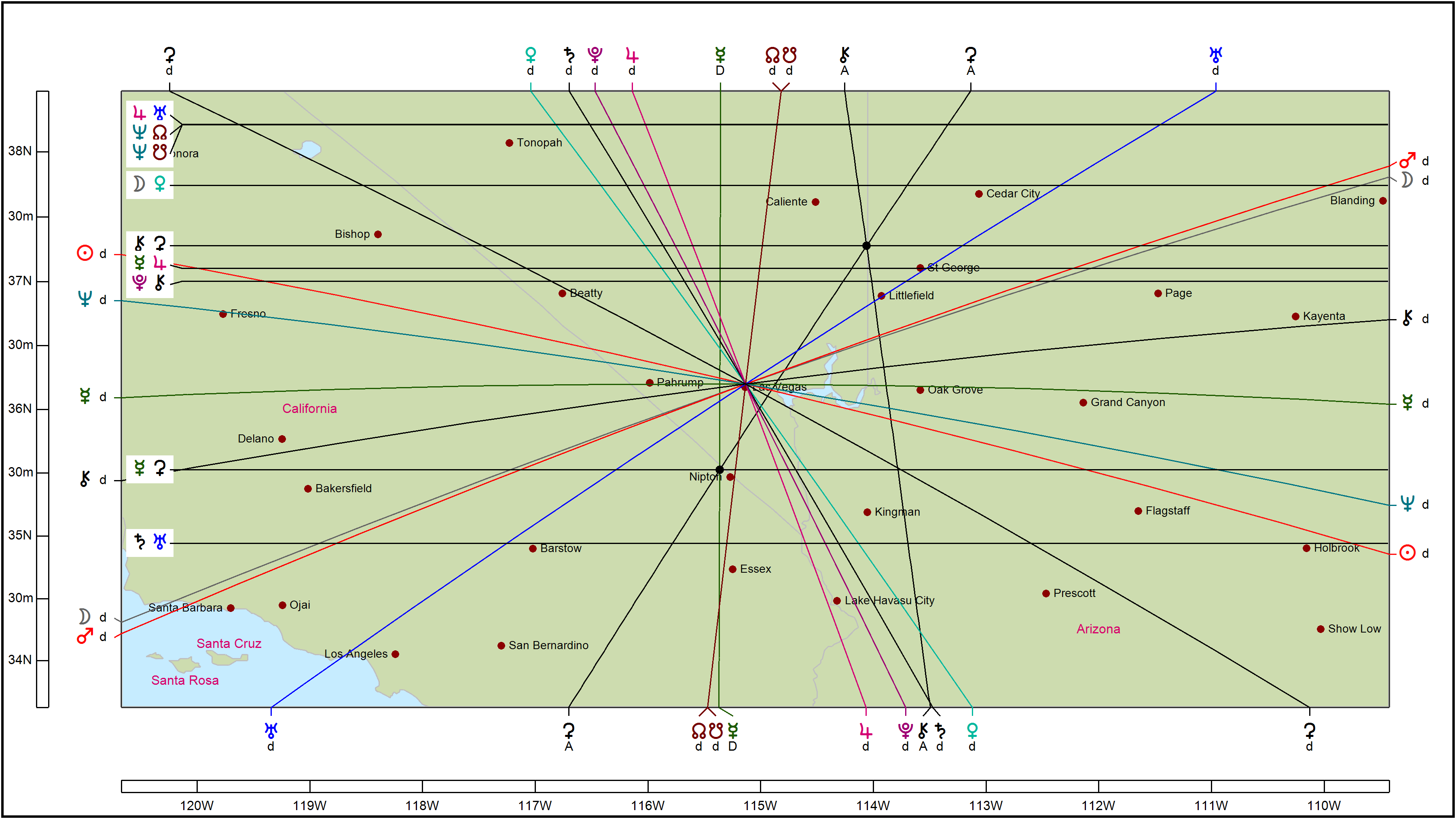
The way I use it, and they way you'll see the lines displayed in most astrology mapping software can be divided into three categories; Planetary Angles, Parans, and Local Space Lines. In the above image all three types of these lines are present, but if we don't understand the difference between the three types of lines then trying to determine what is happening on the map can become confusing and convoluted.
In addition to the content below, here is a video I put together explaining the difference between the three types of astrology map lines and how they all come together:
1. Planetary Angle Lines
There are four planetary angles in the natal chart where planets have a very strong emphasis of power. These include:
Ascendant
- (Asc) When a planet is rising over the Eastern Horizon
Descendant
- (Dsc) When a planet is setting over the Western Horizon
Midheaven
- (MC) When a planet is directly overhead
Imum Coeli
- (IC) When a planet is on the opposite side of the Earth
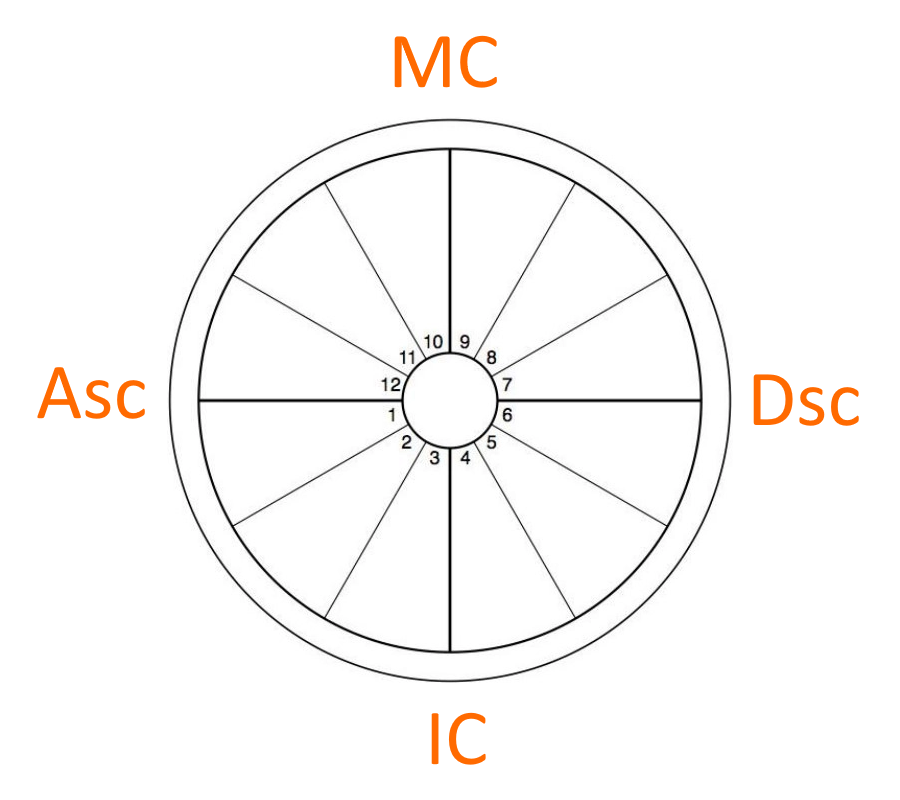
The astrology map lines related to the four angles can be determined by the capital "A," "D," "M," and "I" respectively. There are other lines that sometimes look to be going vertical in addition to these, but those are local space lines that happen to be spanning vertically as well. Local space lines are discussed further down this page. You can tell the difference because the local space lines are represented by lower case "d."
Continuing from the above example, here I removed the local space lines from the map to clearly show three Planetary Angle Lines present; Mercury Descendant, Chiron Ascendant, and Ceres Ascendant. This would indicate that Chiron and Ceres are very close to one another rising near the Ascendant while Mercury is opposite them setting over the Descendant at the time captured for the chart near these locations.
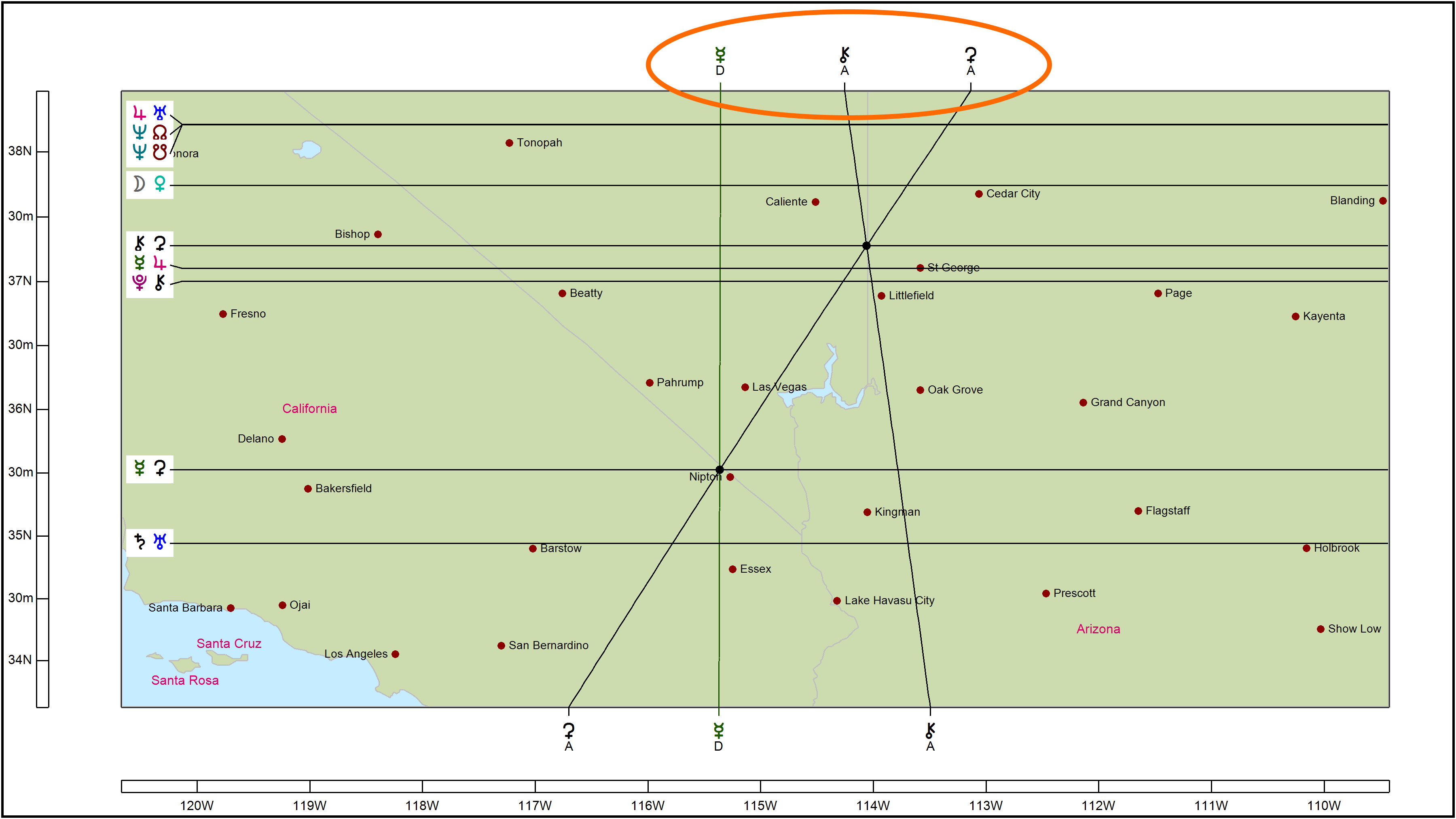
Planetary angle lines are the most common lines in Astrocartography, which was discovered by Jim Lewis who was the originator of taking these most powerfully positioned planetary angles and mapping where they occurred based on the natal chart.
But a lot has evolved since these lines were originally discovered. In the past it was thought that you could simply move to a beneficial line like Jupiter and experience all sorts of abundance and success, but in fact the results of moving near these lines is much more nuanced than that.
East or West?
For one, there is a stark difference between being East or West of these planetary angle lines because the direction from the line determines what house that planet is in based on the relocation chart. For instance, if you move just west of your Uranus Descendant Line it would be in your 7th House, which would indicate themes around independence in relationships, career exposure, and an active social life. Whereas if you were to move just east of your Uranus Descendant Line it would be a 6th House placement, which could lead to health issues and other quick and unexpected ordeals.
The example below shows a Uranus Descendant Line going through Polynesia. So if you were planning a trip to this region, with all else being equal, you would would be more inclined to go to Fiji rather than Somoa for instance. Fiji being on the 7th House side would indicate an exciting social experience. Somoa being on the 6th House side would indicate the risk of unexpected problems to deal with.
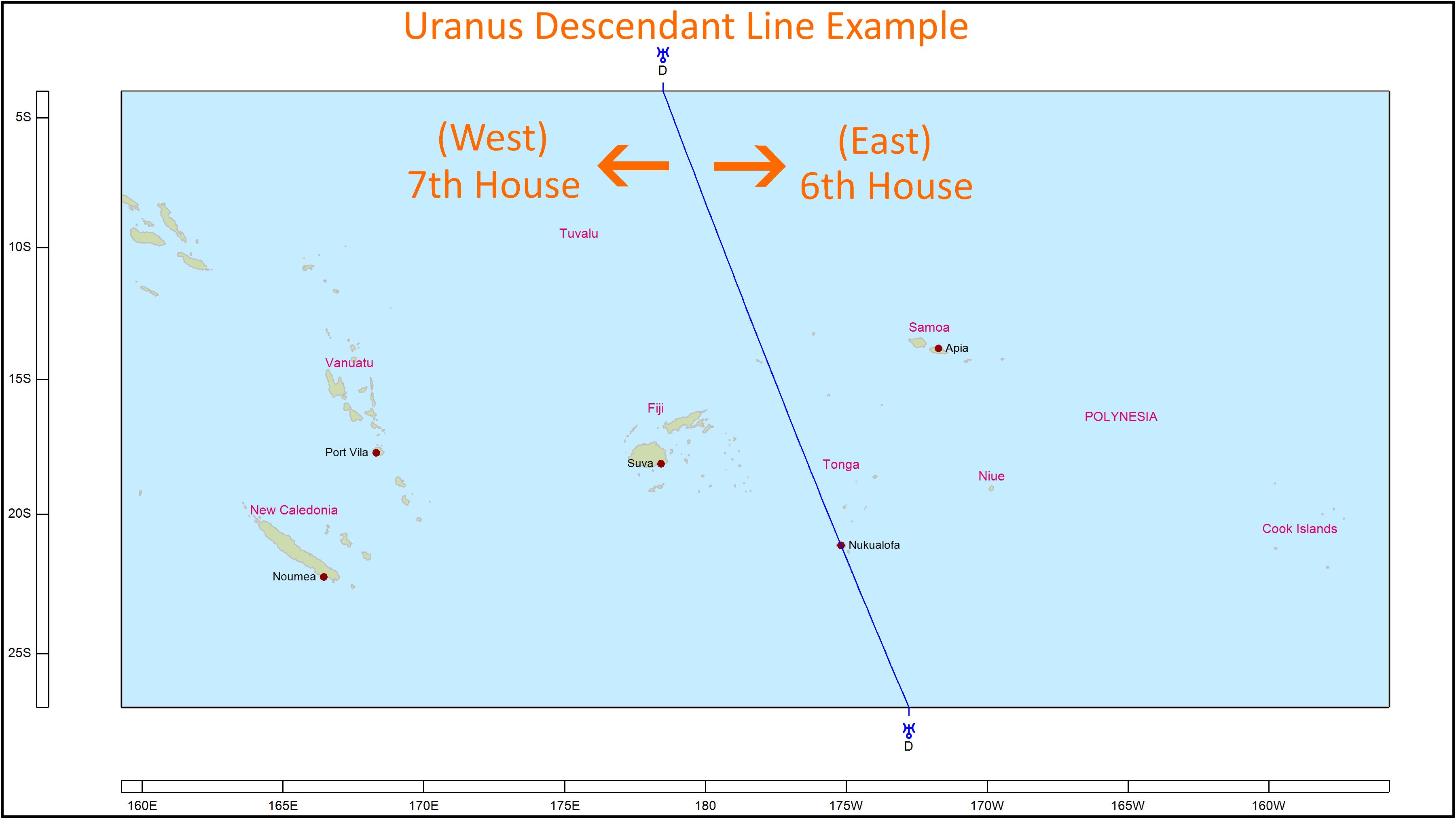
Of course there are a lot more influences to consider than a single Planetary Angle line, the above example is simply to show you how to begin looking at these powerful angle lines. Here is what this same map looks like with all the other lines included. As you can see, there is a lot more to consider!
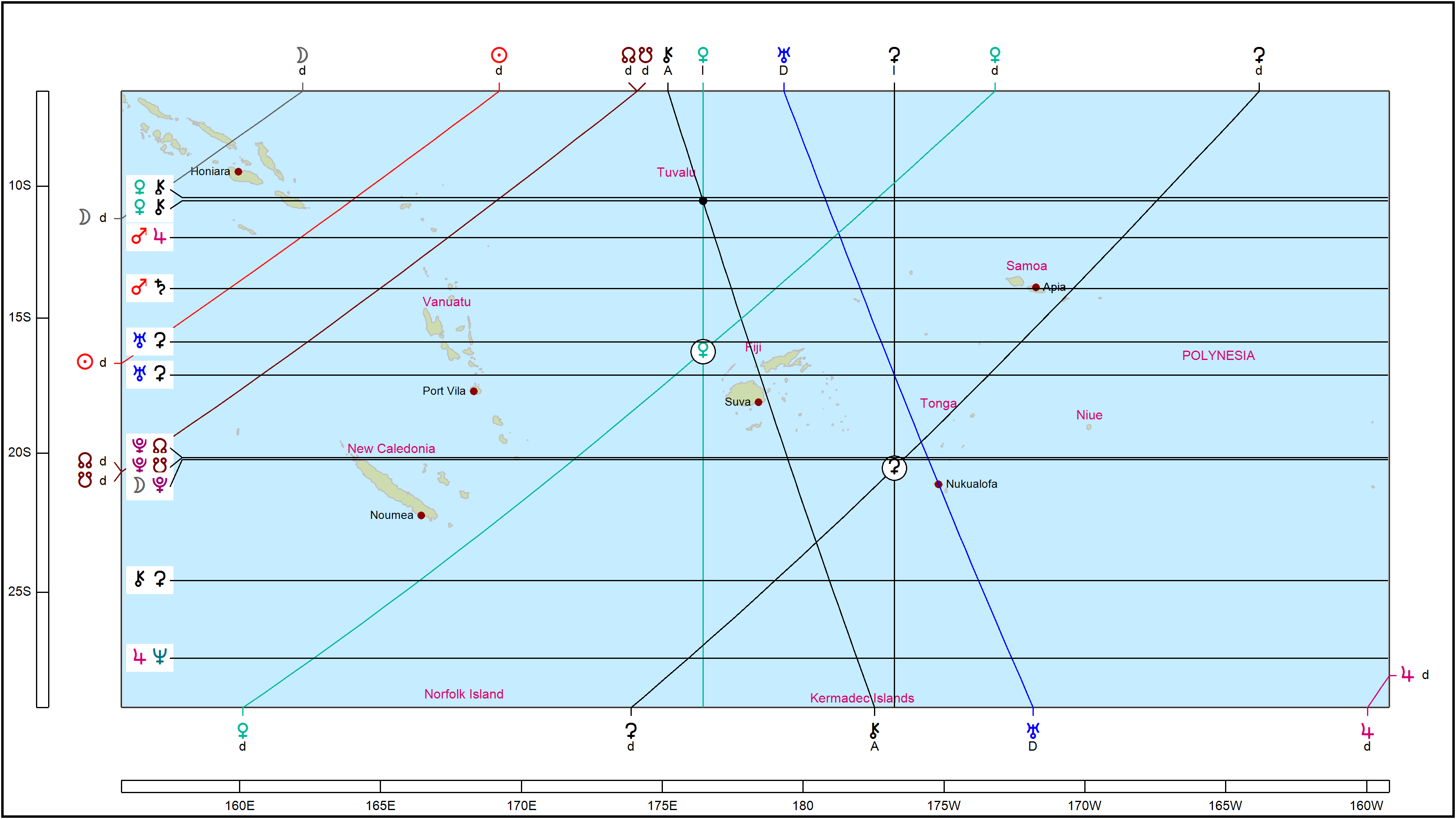
Venus Ascendant Line

Many people look to their Venus lines when looking for romance and relationships, with the Venus Ascendant Line being the most popular choice of them all. Here is an example of the difference between moving East or West of your Venus Ascendant Line.
Zodiacal Vs. In-Mundo Positions
There is also the calculation of these lines to consider. There are two calculation methods for the planetary angles as they are reflected on the map, zodiacal and in-mundo. When you see them laid on a map they are usually calculated in-mundo, which means their actual position in the sky as they deviate from the orbital plane. Their zodiacal position is what is seen on the wheel chart, as though all the planets were merged onto the ecliptic with no deviation. Many times there is not much of a difference between the two calculations, but certain planets like Pluto wobble further from the ecliptic so their calculations can be further off.
Both calculations work so we need to be aware of both of them. And this can lead to instances where you can be west of the line in one calculation and east of the line in the other. So you would need to incorporate the significations of both positions into one interpretation.
2. Paran Latitudinal Lines
Parans are the horizontal lines you see going across the map parallel from one another. They are formed at places on the globe where two planets are on angles at the some moment in time and space.
When this happens, it is as if these two planets combine their significations and create a very specific planetary energy at that exact latitude all around the Earth. When two planets come together in this way it creates a situation where they combine their natural qualities and manifest their results together, as if they were tightly conjunct, creating a unique set of energy and circumstances to work with.
Continuing from the first example, here we see multiple parans spanning horizontally across the map. I also noted two instances of paran lines being formed. They are formed when two planets are on angles at the same time and place, but this phenomenon is illustrated on the astrology map by two planetary angle lines crossing.
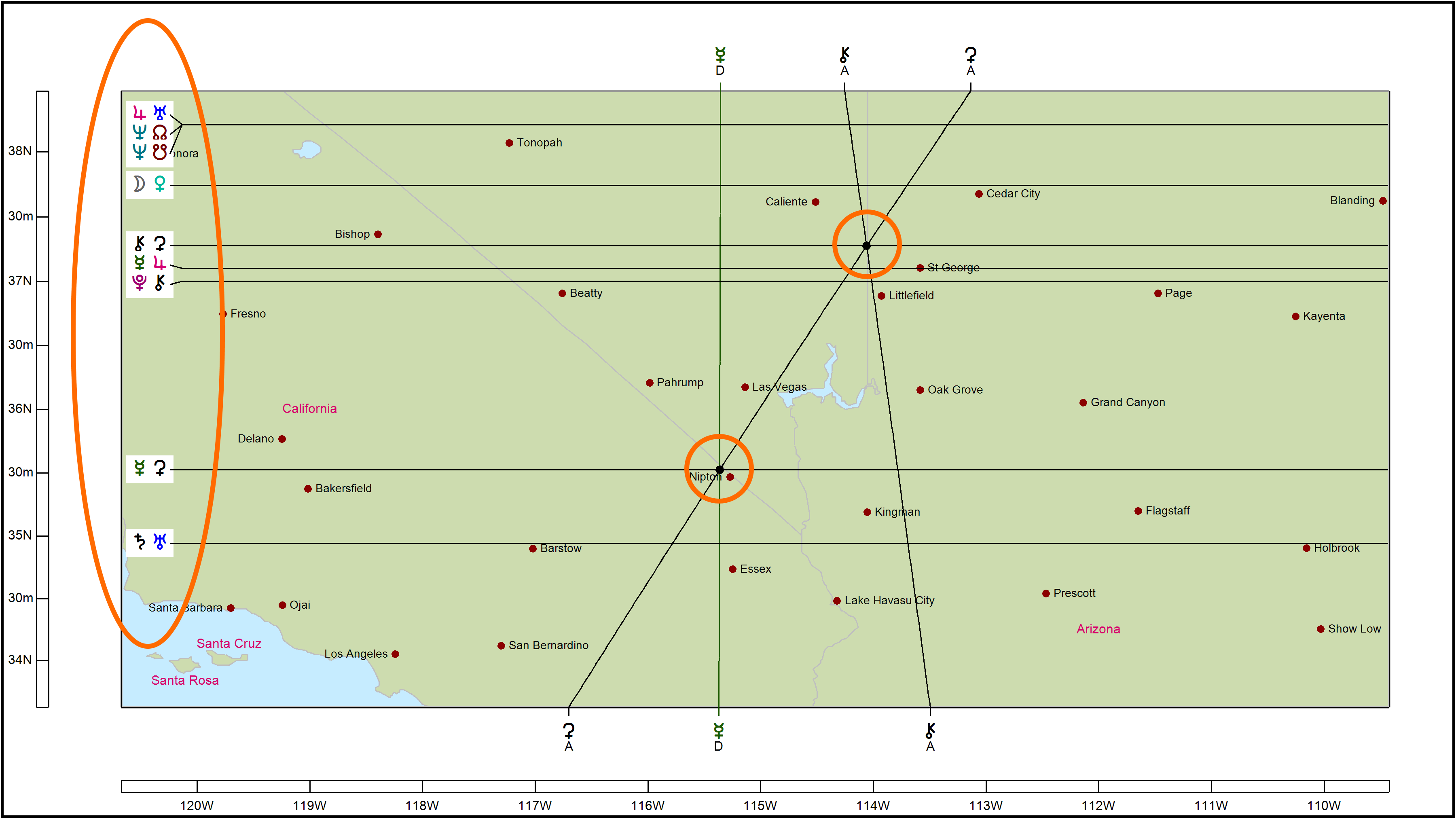
The top crossing creates a Chiron-Ceres Paran, which would be a location where someone has a lot of emotional stuff to work through, but possibly have uplifting and comforting resources to help them in the process. Not usually a great line in general, but could be good for someone who is a healer, or into alternative modes of doing things.
The lower crossing creates a Mercury-Ceres Paran, which would be good for intellectual endeavors. It would be a great location for someone who wanted to write. It's also good for social matters, where you might have supportive friends.
The rest of the parans on the map we see here were formed somewhere else on the globe at these particular latitudes. For instance, there is a Mercury-Jupiter paran just below the Chiron-Ceres paran. This Mercury-Jupiter paran happened to be formed with Mercury on the IC while Jupiter was on the Descendant at a coordinate in the Atlantic Ocean, not too far off the coast of Portugal. But this same Mercury-Jupiter energy can be felt around the world at that same latitude, in this case shown in the western United States.
Living near a Mercury-Jupiter Paran you would expect to have better fortune and expansion in the areas of business, communications, education, law, and more because these are two benefic planets coming together enhancing one another's beneficial qualities that they both naturally want to provide.
Parans have a relatively narrow band of influence, so in order to experience their effect you need to stay within 70 miles of that latitude, the closer you are to the exact latitude of the paran the stronger its influence will be. Over 70 miles away its effects will likely not be felt.
On the same note, if you are near a difficult paran, like Mars-Rāhu and you've been experiencing accidents and other painful situations you simply need to move 70 miles away or more in order to alleviate those difficult energies.
3. Local Space Lines
Local space lines are a visual representation of the direction you would go if you were to follow a planet's actual placement in the sky from your birth location at the moment you were born.
In the example below you can see the planetary lines going out in every direction, all from the same central point, that would be the birth place. You'll notice that each planet spans out in opposite directions from itself. In this case, the planet you are following is in one of those directions in the sky, but that direction loops around the globe leading back to its starting point, so you can think of that line wrapping around the Earth all the way back to its starting point.
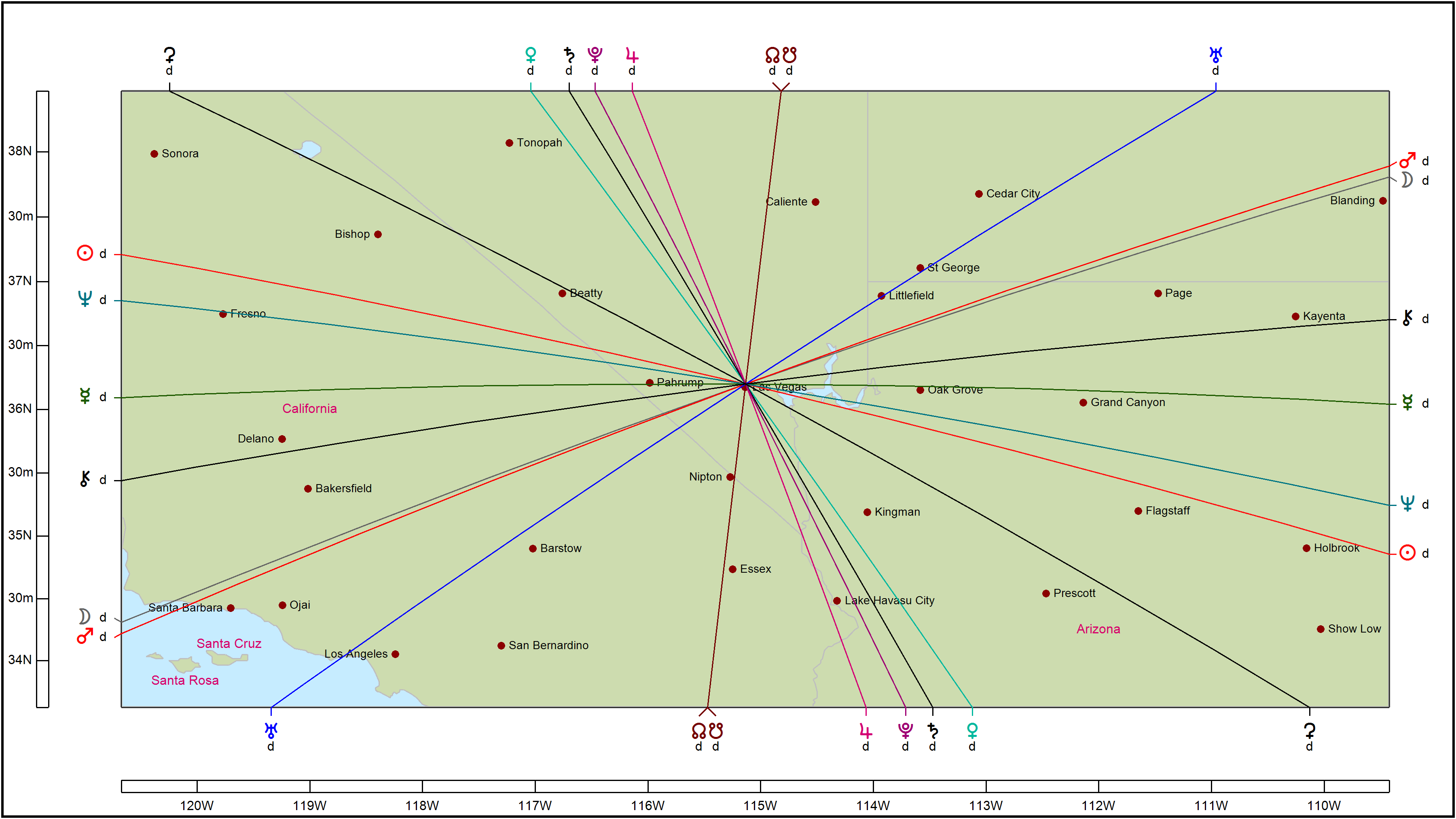
The term "local space" can sometimes be a confusing because you can follow your local space lines all around the globe. They are called local space lines because they are relative to the placement of the planets from the location you were born. So wherever you move in the world you may be following your local space lines in some capacity or another.
The closer you follow these planets the stronger their influence would be, as if you were activating their influence relative to how the planet is placed in your natal chart. I refer to this as the strength and status of the planet. If a planet is weak it may increase the manifestations of the difficulties related to the planet, whereas if the planet is strong it will enhance the positive manifestations
The Importance of Planetary Strength
If a planet has sign strength, strong aspects, and directional strength then it will produce much stronger results than if the opposite were true; difficult sign placement, tough aspects, and a difficult house placement for that planet would not be very appealing, even if it were a benefic planet. This is because the planet will have a hard time manifesting its positive results.
Analyzing a birth chart can be pretty involved, and there are various methods for doing so, but it is an important component to understanding how all the planets will manifest their energies on your astrology map. I go into detail on the Birth Chart Analysis page on how to read a birth chart. But since I come from a Vedic Astrology background, this is the approach I use. If you come from a Western Astrology background it is just as fine to use the techniques that you've already learned. The important part is simply knowing how strong a planet is before analyzing what the planet is doing on the map.
Venus Local Space Line Example

If you follow your Venus local space line, for example, and your Venus has several malefic aspects and is in a difficult house then you will be enhancing stories around difficulty in relationships. If your Venus is strong and well placed in your natal chart and you follow your Venus local space line you will be activating more positive relationship situations in your life.
To expand a little further with this example, Venus can also represent girl friends, fun, pleasure, material comforts, diplomacy, and more. So if you were to follow your Venus local space line you would want to take these significations into account as well.
We would also need to consider its sign and house placement, for instance an exalted Venus in Pisces in the 9th House would enhance fun, fortune, and happiness in an inspired way, possibly leading to things like higher education, philosophy, fine arts, and luxury. Whereas, a debilitated Venus in Virgo in the 6th House would emphasize relationship troubles, aggression from women, and even health problems.
So as you can see, it is important to understand how the planets are doing in your natal chart in order to know how they will manifest their energies if you are to emphasize them by following their local space lines.
Relocation Charts
Proper analysis in locational astrology goes a step beyond looking only at the astrology map. Every town or city on the map that you consider should be accompanied by a relocation chart for that place. This is because we also need to see what planets are being activated on the House Cusps for these locations, which we cannot see on the map itself. So once you find locations that might seem interesting based on the convergence of certain lines on the astrology map, then you can dive deeper into specific locations by looking at their relocation charts.
Astrology Map Lines Summary
There are three types of astrology map lines which all have unique calculations and attributes, and when combined they can create a well rounded interpretation of the planetary qualities that can manifest in any given location. But please remember that there is more to consider than what can be seen only on the astrology map.
Here is a recap of the three types of astrology map lines covered here:
Planetary Angle Lines
- These lines are powerful but you need to be aware of which side of the line you are on and how well that planet is placed in your natal chart, and how those planets typically perform in the corresponding houses.
Paran Latitudinal Lines
- These lines are formed by two planets combining their energy, running horizontally around the globe. The results they produce are based on the natural significations of the planets and not usually determined by the placement of the planets in the natal chart, unless it is an extreme case.
Local Space Lines
- These lines are formed by following the direction of the planets in the sky from the location you were born. It is important to see how well they are placed in your natal chart to determine how they will function.
Related Pages
Venus Ascendant Line
The Venus Ascendant line is sought after for finding love and relationships in Astrocartography, Find out what to expect when moving to this astrology map line.
Locational Astrology
Locational astrology is the total make up of all planetary influences in a geographic location, including planet strength, astromap, relocation charts, and timing.
Relocation Charts
Diving deeper than the lines on your astrology map, you'll also want to know the planetary activations for your astrology relocation chart, in each location you consider.
"Inside the Sun" Astrology Newsletter Signup
*By signing up for this newsletter you agree to receive periodic emails from insidethesun.com.
You can unsubscribe at anytime.
